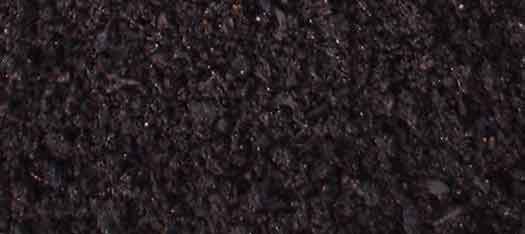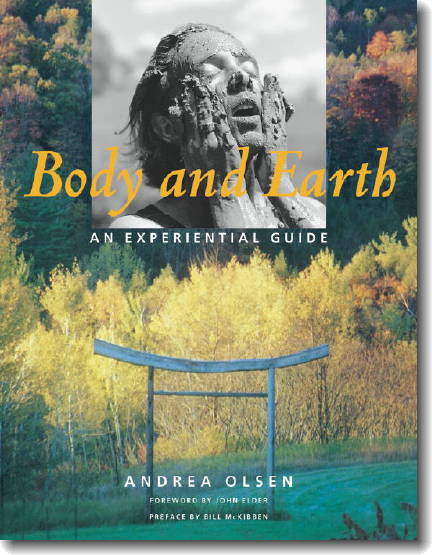
Key adventures that help connecting with the planet through the body include Soil/Skin and Ten Questions to Ask the Soil (Olsen), Make a Terragram (Hauk), Gaia Meditation (Seed and Macy), and Human/Earth Bonding (Dolores LaChapelle). Several other relevant books and resources are also available.
Questions to Ask the Soil

Activities Related to Soil featured in Andrea Olsen's Body and Earth: An Experiential Guide (2009, pages 105-111) include 10 questions to ask the soil, the restorative yoga posture of corpse pose (savasana), and a place visit with attention to soil.
From Ten Questions to Ask the Soil (2-4 hours) (pp. 109-110)
Consider the soil where you live; begin by asking these questions:
- What are you made of? (Notice protruding bedrock, the parent material of soil, as well as the proportion of pebbles, sand, silt, and clay; notice the vegetation, animals, and microscopic organisms forming the decaying organic material in the humus.)
- Do you have specific geological markings here or nearby? (Consider mountains, road cuts, faults, cliffs, and waterfalls.)
- Do you show signs of glacial activity? (Look for boulders in the middle of fields or woods, hills comprised mostly of sand and gravel, glacial ponds or potholes, scoured rocks.)
- What grows in you, here and nearby, naturally and commercially? (Notice trees, grasses, crops, orchards; watch for telltale insects and birds.)
- Do you show signs of erosion by wind or water? (Consider muddy water, rounded mountains, barren hilltops, washed-out road gullies, and dust in the air.)
- What rocks do you contain? (Identify two, using a field guide; note if they are igneous [formed from fire], sedimentary [formed under water], or metamorphic [formed under pressure].)
- What do you do about water? (Consider slope, rivers, wetlands, and ponds; note the textures [dry or saturated]; note soil implications for drinking water; consider drainage ditche, culverts.) …
Draw a Terragram

Making a Terragram requires a pen and a piece of paper, potentially some conversations with family, some revery and imagination. Draw a family tree backwards of people and places. When did your ancestors lose or leave their homeland? Note the reasons for the shift, including if there is historical trauma (genocide, colonization, abduction for slavery, pogrom, exile, famine, terror, war, or displacement). What was their relationship with their new place like? For your own and the two previous generations, note where families lived, how many times moves were made, what were the connections with place? Note each move with a lightning bolt. When was the last time a generation or folk in your family gardened or farmed, what were the circumstances? Lived rurally? How did different people and generations connect with nature? For your own life, draw yourself as a central circle and around you connect an array of circles to yourself, each a resource, each circle can represent a place, spot on earth and Terra. Draw lines and make notations regarding the relationships between these place-entities and with yourself. These could include the backyard mud pie pit growing up, the neighbor's oak tree you used to climb, the walk home from school, a nearby wild lot, to your current place-sources. What are your relationships with these places? How frequently do you go there? What is your time like? Draw dotted lined circles for places you are intrigued by but do not yet spend time in. Stand back and study the patterns and maps. This Terra-genogram and Terra-eco-map combine to form a Terragram of your history and current access to and relationship with place connection and how it maps to the body of your life and family, to your heart and spirit.
"The Terragram includes the family systems and spiritual resource views while focusing attention on the intergenerationally-influenced and current relationship with Terra— place, land/homeland, nature, and Earth." (Hauk, 2010, p. 7).
Gaia Meditation

"This simple, spoken Gaia Meditation guides us into precise and close identification with the elements, and with Earth's geohistory and life history. This meditation can also be done in pairs, contemplating one another while listening to the words" (Macy and Brown, Coming Back to Life, p. 185).
Excerpt: "...Think to your next death. Will your flesh and bones back into the cycle. Surrender. Love the plump worms you will become. Launder your weary being through the fountain of life.
Beholding you, I behold as well all the different creatures that compose you- the mitochondria in the cells, the intestinal bacteria, the life teeming on the surface of the skin. The great symbiosis that is you. The incredible coordination and cooperation of countless beings. You are that, too, just as your body is part of a much larger symbiosis, living in wider reciprocities. Be conscious of that give-and-take when you move among trees. Breathe your pure carbon dioxide on a leaf and sense it is breathing fresh oxygen back to you..."
Human/Earth Bonding

Deep ecologist Dolores LaChapelle (1988, pp. 268-309) offers Seven Ways to Human/Earth Bonding: Boundary crossings between wilderness and civilization. They include Cleansing, Chanting, Drumming, the Way of the Dance, the Talking Staff (especially about mutuality and listening), the Way of the Bard, and the Tai Chi Way.
On Mutuality: "Listening is just as important as speaking. As each person speaks from the heart, all the others listen in a manner seldom permitted in our current...culture. This mutual interaction has two aspects. First, you speak from the innermost depths, taking as much time or as many false starts as is needed to communicate what is important, knowing that no one will interrupt you. Then, having opened up to those depths...you find there's no need to defend what you just said because there can be no questions. You pass the staff onto the next person and begin listening just as intently as you have been speaking....As the staff moves on around the circle, you understand more of what you just said and you find that the others are moving in that direction so by the time it gets back to you, there's a sense of delight and abundance which spills out...." (p. 293)
En-earthing involves not only direct sensory experience of wilderness, but also the embodied interrelationship of humans with nature and Earth. These direct relationships and "physical, sensuous, and emotional connections" and fluid boundaries "may recover a sense of the Earth as a living being, sustaining manifold forms of life…understandings of the links between the cycles of the body and the cosmos" (Diamond, 1994, p. 46).
Ancient somatic practices en-earth humans, re-embedding us in the life of the world. Chalquist (2007) describes the imaginal presence of a place manifest as a living, reactive field (p. 57). He investigates how the alchemists explored "a heightened participatory consciousness- animism as a quality of active engagement with things" (p. 93) wherein these researchers could "hear the psychic sound of an animated world, with the substances they sought to transform serving as psychological portals into the world's interiority." (p. 94).
This embodied sense of relational connection with nature and things as living beings, accompanied with an awakening and extension of the senses and embodied experience, is the hallmark of en-earthing. LaChapelle (2002) advocates for "reciprocal appropriation" of humans and nature as appropriate, intimate engagement, as disclosure, compliancy, and interstitial incorporation (pp. 21-23). For LaChapelle, practices such as tai chi help humans embody the "realization of the interrelationships inherent in all of nature," to cultivate a sense of how everything is connected and how everything is always changing (p. 16): how the changing sky and earth produce the seasons (p. 20) around and in us.
En-earthing encourages earth empathy. Rifkin (2010), speaking about Empathic Civilization: The Race to Global Consciousness in a World in Crisis, posits that, "as Homo empathicus, our core nature is not sinful, depraved, utilitarian, materialistic, or self-interested, but it is to seek intimacy, affection, companionship and to extend empathy to others."
In this exploration, en-earthing involves refiguring our context. Instead of Cartesian cartography from an abstracted God's-eye view, other forms of Earth mapping embed us in and as the landscape. From this new (ancient) context, our sensory awakening enables us to expand our wisdom sources. Dream, dance, somatics and sensuality, celebration and ritual are, in the words of LaChapelle (1995), patterns that reconnect. By re-embedding ourselves with/in nature, by awakening and extending our senses in this expanded embodiment, by meditative and ecstatic movement and awareness and joy, we en-earth. En-earthing nurtures and embodies earth empathy so that humankind can re-inhabit wisdom in, of, and as the world.
Overview from Hauk, M. (2010-March) En-Earthing: Aligning and Awakening Our Embodied Presence as the Planet. Unpublished Manuscript. Prescott College, Arizona.
Quoted inline and not appearing below:
- Diamond, I (1994). Fertile ground: Women, Earth, and the limits of control. Boston: Beacon.
- Rifkin, J. (2009). The empathic civilization: The race to global consciousness in a world in crisis. New York: J.P. Tarcher/Penguin.
We have a beautiful
mother
Her green lap
immense
Her brown embrace
eternal
Her blue body
everything
we know.
Alice Walker (1991). Excerpted from "We Have a Beautiful Mother," p. 460, in Her Blue Body Everything We Know. San Diego, CA: Harcourt Brace.
Many books exist with a wealth of resources and activities on Body/Planet connections, including an extensive listing for Gaian research methods. Key resources include:
- Abram, D. (2010). Becoming animal: An earthly cosmology. New York: Pantheon Books.
- Barrett, M.J. (2009). Beyond human-nature-spirit boundaries: Researching with animate Earth. Dissertation, Published online at http://education.uregina.ca/porosity/
- Brooks, C. V. W., Selver, C., Lowe, R., & Laeng-Gilliatt, S. (2007). Reclaiming vitality and presence: Sensory awareness as a practice for life. Berkeley, Calif: North Atlantic Books.
- Chalquist, C. (2007). Terrapsychology: Re-engaging the soul of place. New Orleans: Spring Journal Books.
- Chalquist, C. (2010). Rebearths: Conversations with a World Ensouled. World Soul Books.
- Clinebell, H. J. (1996). Ecotherapy: Healing ourselves, healing the earth: A guide to ecologically grounded personality theory, spirituality, therapy, and education. Minneapolis: Fortress Press.
- Cohen, M. (2007). Reconnecting with nature: Finding wellness through restoring your bond with the Earth. Lakeville, MN: Finney/Ecopress.
- Griffin, S. (1999). What her body thought: A journey into the shadows. San Francisco: HarperSanFrancisco.
- Harding, S. (2006). Animate earth: Science, intuition and Gaia. White River Junction, Vt: Chelsea Green Pub. Co.
- Hauk, M. (2010). Regeneration from work and technology addiction with Terragrams and ecotherapeutic approaches. Manuscript submitted for publication.
- LaChapelle, D. (1988). Sacred land, sacred sex: Rapture of the deep: Concerning deep ecology and celebrating life. Durango, CO: Kivakí Press.
- LaChapelle, D. (2002). Return to mountain tai chi: Between heaven and earth. New Zealand: Hazard Publishing.
- Macy, J. (2007). World as lover, world as self: Courage for global justice and ecological renewal. Berkeley, CA: Parallax Press.
- Macy, J., & Brown, M. Y. (1998). Coming back to life: Practices to reconnect our lives, our world. Gabriola Island, BC, Canada: New Society Publishers.
- Margulis, L., & Sagan, D. (2007). Dazzle gradually: Reflections on the nature of nature. White River Junction, VT: Chelsea Green Pub.
- Mathews, F. (1994). Ecological Self. London: Routledge.
- Morrison, A. L. (2009). Embodying Sentience. In Buzzell, L. & Chalquist, C., Ecotherapy: Healing with Nature in Mind (pp. 104-110). San Francisco, CA: Sierra Club Books.
- SPOTLIGHT: Olsen, A. (2002). Body and earth: An experiential guide. Middlebury bicentennial series in environmental studies. Hanover, NH: Middlebury College Press.
- Sahtouris, E. (2000). Earthdance: Living systems in evolution. San Jose, CA: IUniversity Press.
- Seed, J., et al. (1988). Thinking like a mountain: Towards a council of all beings. Philadelphia, PA: New Society Publishers.





